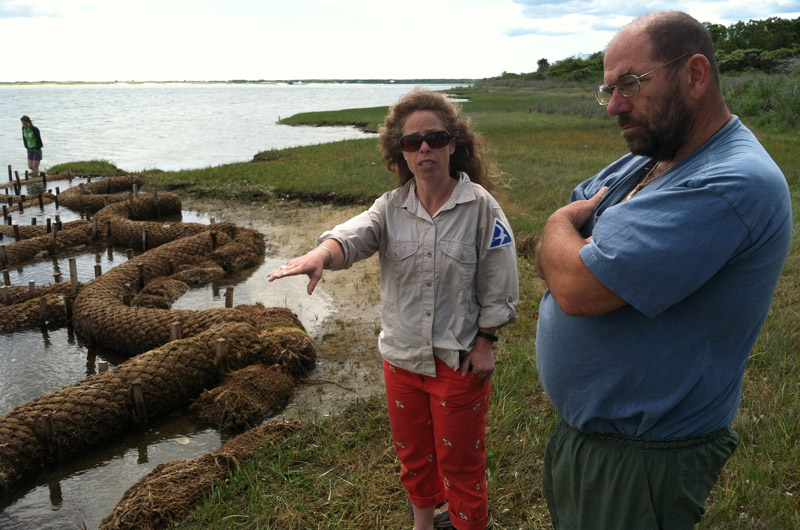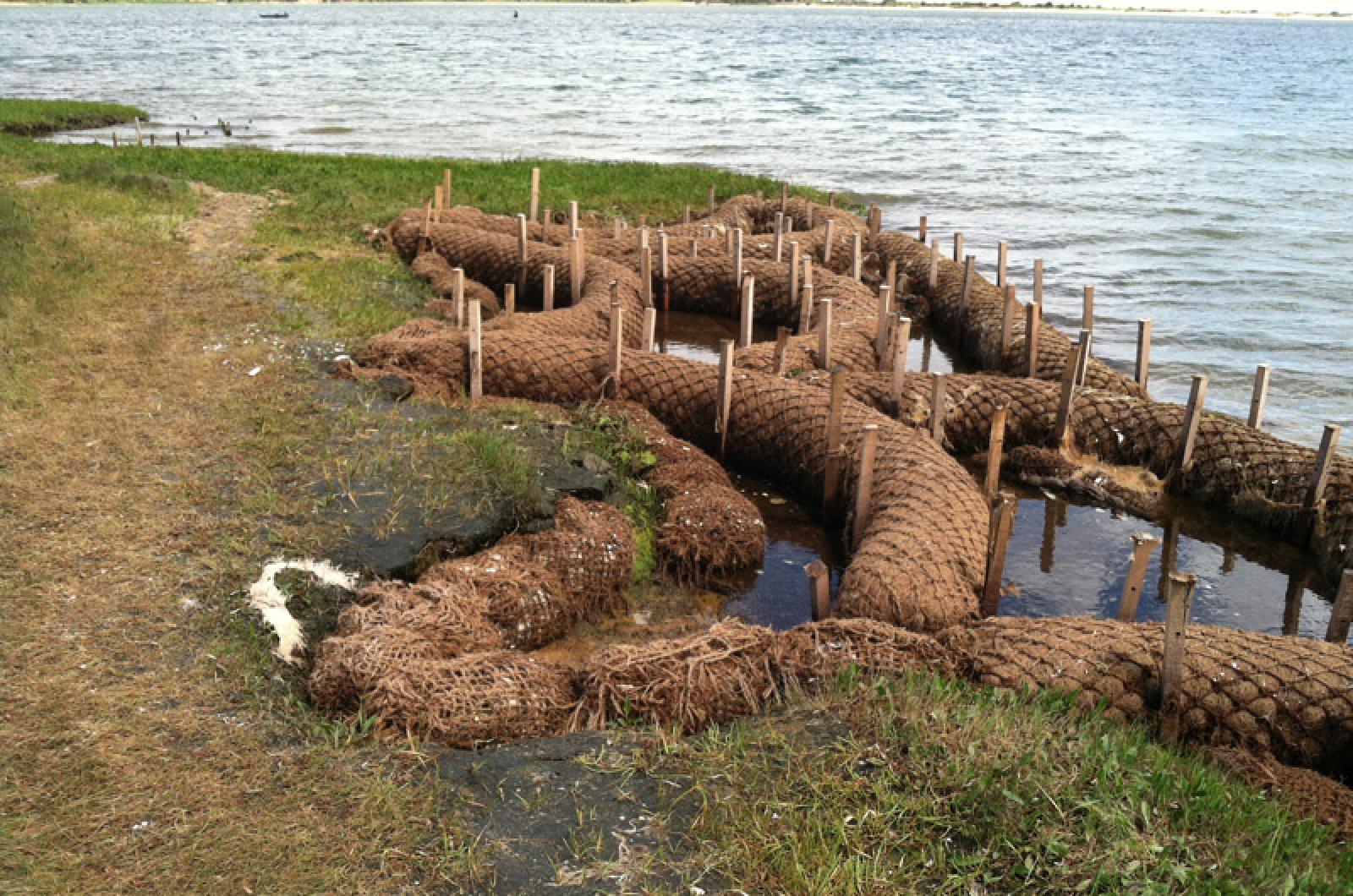Efforts to protect the eroding shoreline at the Felix Neck Wildlife Refuge have taken a major step forward with the installation of the Island’s first full-scale living shoreline project.
On a windy day this week, two visitors stood on a soggy trail and pondered the massive coir logs arching outward into Sengekontacket Pond and forming a series of pools near the shore. Each 10-foot log, made of dense coconut fibers, was held firmly in place with wooden stakes, and heavy shell-filled sacks rimmed the 100-foot structure.
The living shoreline will serve as a laboratory for a number of projects in the coming years, although its main purpose is to stabilize and restore the marsh in the face of storms and rising seas.

The towns of Oak Bluffs and Edgartown voted last year to contribute $9,700 each to the project, which may eventually cover three 100-foot sections along the shoreline. The U.S. Environmental Protection Agency has also provided funding and technical support.
The salt marsh at Felix Neck has lost several feet in recent years as the result of rising seas and more frequent storms. The scouring is evident along the shore, where it has threatened a well-used walking trail. “In the last three years it’s gotten significantly worse,” Felix Neck wildlife director Suzan Bellincampi said this week, looking out over the pond where small waves crashed into the coir logs.
Oak Bluffs shellfish constable David Grunden, who had the idea for a living shoreline two years ago, agreed that recent climate change and more frequent storms have worsened the erosion.
The structure itself hadn’t changed much since it was installed on June 1, which was a promising sign. And already a number of marine species — including black snails, fiddler crabs and hermit crabs — have appeared in the crescent-shaped pools that researchers hope will fill with sediment and rebuild the shoreline.
“This will be gone in three to four years,” Ms. Bellincampi said of the massive coir logs and shell-filled bags, which are entirely biodegradable. “Eventually, we hope, all this will be marsh.”
Just north along the shoreline lie the remains of a pilot project by the Martha’s Vineyard Shellfish Group, which set the stage for the living shoreline. Those materials have mostly washed away, leaving behind a skeleton of wooden stakes. The new version includes many more logs and bags, and covers more ground. And learning from the past, designers used longer and stronger stakes.
More than a dozen people helped install the structure this month, including members of Felix Neck, the Edgartown and Oak Bluffs shellfish departments, the EPA Atlantic Ecology Division, and the University of Rhode Island. The wide partnership plans to add two more living shorelines to the south this summer.
“It was a much bigger project than we were first talking about, and that’s because the EPA saw the opportunity to do this and to get some answers to their questions as well,” Mr. Grunden said.
More than just restoring the marsh, the project will provide valuable scientific data on the area, and a deeper understanding of how the public responds to shoreline restoration efforts.
Lauren Josephs, a graduate student at the University of Rhode Island, waded out into the pond on Monday to inspect the logs and burlap sacks, which have already begun collecting sediment on the outer edge. But Ms. Josephs’ involvement in the project has more to do with the people who encounter it than the project itself.
“The science could say it’s working,” Ms. Josephs said. “But that’s sometimes really hard to see with the naked eye, and it might take a lot of time. Another whole part (to me) of whether a restoration project is successful is how it’s received by people and what they think about it and whether they think it’s the right idea.”
“This is such a cool opportunity,” she added, “because people are going to be exposed to it in so many different ways.”
Visitors have already begun noticing the unfamiliar objects and asking questions. Ms. Josephs will speak with visitors this summer and distribute questionnaires to learn about how they experience the project. She believed it would take years to fully gauge its success, although Ms. Bellincampi anticipated at least a general impression from visitors much sooner.
To further support Ms. Josephs’ work, Mr. Grunden has informed Island Spirit Kayak of the project so their tour guides can explain it from the water. And Felix Neck will distribute information at its visitor center and install signs for self-guided tours.
Ms. Bellincampi will encourage citizen scientists, along with birders, campers, school groups and others who use the sanctuary, to engage with the project and help with the next phases.
“When you look at this, you are going to want to know what it is,” she said. “To start that conversation is really important.”
The project will also shed light on the problem of eutrophication, which has affected nearly every coastal pond in the state, including Sengekontacket, mostly as a result of nitrogen from septic tanks. In addition to the living shorelines project, the Oak Bluffs and Edgartown shellfish departments both have launched oyster growing programs to remove nitrogen from the pond.
Salt marshes also attenuate nitrogen from the water, but a receding shoreline and the absence of cordgrass has likely hampered that process at Felix Neck. The EPA’s involvement will focus largely on monitoring related to nitrogen. Mr. Grunden hopes to be able to plant cordgrass directly into the logs next year.
The abundance of nitrogen may itself have something to do with the rate of erosion at Felix Neck and elsewhere. Mr. Grunden speculated that with so much nitrogen already present in the soil, the salt marsh grasses along the edge can survive with shorter roots, which further undermines the stability of the shoreline.
Looking ahead, the Martha’s Vineyard Shellfish Group plans to seed the area with ribbed mussels, which could attach to the logs and shoreline, further supporting those structures. Ribbed mussels have largely disappeared from the area as the shoreline erodes.
Unlike many shoreline restoration projects, the living shoreline aims to preserve the natural integrity of the land. “In the past, it was rocks and concrete, and that was pretty much all you’d think to do,” Ms. Josephs said. State and local agencies have since begun encouraging so-called soft solutions, and the living shorelines project was relatively easy to permit.
“We knew that if we recommended hard structures to help break down the wave energy, the storm surge and so forth, it probably would have been denied, at least at the state level,” Mr. Grunden said. “So we tried to keep this is as low as we could.”
The feedback so far has been almost entirely positive, he said, although some people have argued that the towns should focus more on restoring aquatic eelgrass, which supports shellfish and many other pond species. But Mr. Grunden noted that many attempts to restore eelgrass on the Island have failed.
“The areas that have been successful with eelgrass, it starts with [addressing] the nitrogen issue,” he said.
Ms. Bellincampi saw the living shoreline project as many things, including part of a multi-pronged approach to dealing with nitrogen on the Island. “This is a solution,” she added. “And that’s a really great angle to have – that you can do something. It’s not just gloom and doom.”





Comments
Comment policy »